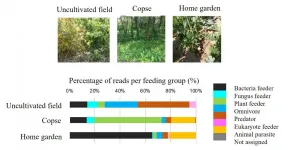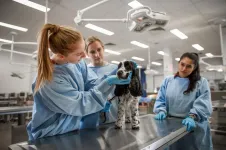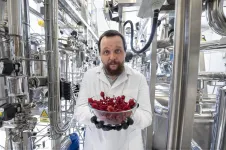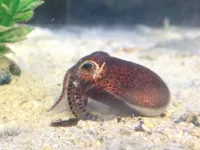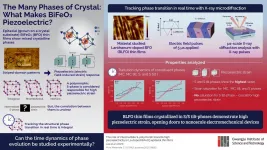(Press-News.org) Overview
The research team of Professor Toshihiko Eki of the Department of Applied Chemistry and Life Science (and Research Center for Agrotechnology and Biotechnology), Toyohashi University of Technology used a next-generation sequencer to develop a highly efficient method to analyze soil nematodes by using the 18S ribosomal RNA gene regions as DNA barcodes. They successfully used this method to reveal characteristics of nematode communities that inhabit fields, copses, and home gardens. In the future, the target will be expanded to cover all soil-dwelling organisms in agricultural soils, etc., to allow investigations into a soil's environment and bio-diversity. This is expected to contribute to advanced agriculture.
Details
Similar to when the UN declared 2015 to be the International Year of Soils, there have recently been many efforts worldwide to raise awareness of the importance of the soil that covers our Earth and its conservation. Diverse groups of organisms such as bacteria, fungi, protists, and small soil animals inhabit the soil, and together they form the soil ecosystem. Nematodes are a representative soil animal; they are a few millimeters long and have a shape resembling a worm. They play an important role in the cycling of soil materials. Many soil nematodes are bacteria feeders, but they have a wide variety of feeding habits, such as feeding on fungi, plant parasitism, or being omnivorous. In particular, plant parasitic nematodes often cause devastating damage to crops. Therefore, the classification and identification of nematodes is also important from an agricultural standpoint. However, nematodes are diverse, and there are over 30,000 species. Additionally, because nematodes resemble one another, morphological identification of nematodes is difficult for anyone but experts.
The research team focused on "DNA barcoding" to identify the species based on their unique nucleotide sequences of a barcode gene, and they established a method using a next-generation sequencer that can decode huge numbers of nucleotide sequences. They used this to analyze nematode communities from different soil environments. Initially, four DNA barcode regions were set for the 18S ribosomal RNA genes shared by eukaryotes. The soil nematodes used for analysis were isolated from an uncultivated field, a copse, and a home garden growing zucchini. The PCR was used to amplify the four gene fragments from the DNA of the nematodes and determine the nucleotide sequences. Additionally, the nematode-derived sequence variants (SVs) representing independent nematode species were identified, and after taxonomical classification and analysis of the SVs, it was revealed that plant parasitizing nematodes were abundant in the copse soil and bacteria feeders were abundant in the soil from the home garden. It was also determined that predatory nematodes and omnivorous nematodes were abundant in the uncultivated field, in addition to bacteria feeders.
This DNA barcoding method using a next-generation sequencer is widely used for the analysis of intestinal microbiota, etc., but analyses of eukaryotes such as nematodes are still in the research stage. This research provides an example of its usefulness for the taxonomic profiling of soil nematodes.
Development Background
Research team leader Toshihiko Eki stated, "Through genetic research, I have been working with nematodes (mainly C. elegans) for around 20 years. As a member of our university's Research Center for Agrotechnology and Biotechnology, I came up with this theme while considering research that we could perform that is related to agriculture. As a test, we isolated nematodes from the university's soybean field and unmanaged flowerbed and analyzed the DNA barcode for each nematode. Bacteria feeders were abundant in the soybean field, and that was used for comparison with the flowerbed, where weed-parasitizing nematodes and their predator nematodes were abundant. This discovery was the start of our research (Morise et al., PLoS ONE, 2012). If that method using one-by-one DNA sequencing was the first generation, the current method using the next-generation sequencer is the second generation, and we were able to clarify characteristics of nematode communities representing the three ecologically different soil environments according to expectations."
Future Outlook
Currently, the research team is developing the third-generation DNA barcoding method which involves purifying DNA directly from the soil and analyzing the organisms in the whole soil instead of isolating and analyzing any particular soil-dwelling organisms. They are currently analyzing the soil biota of cabbage fields, etc. They are aiming to precisely analyze how communities of soil-dwelling organisms including microbes change with crop growth, clarify the effects that cultivated plants have on these organisms, and investigate biota closely related to plant diseases. If this research moves forward, crops can be cultivated and managed logically based on biological data in agricultural soils, and it can contribute to advancing smart agriculture in Japan, such as in the prominent Higashi-Mikawa agriculture region and beyond.
INFORMATION:
This research was performed with the support of the Takahashi Industrial and Economic Research Foundation.
Reference
Harutaro Kenmotsu, Masahiro Ishikawa, Tomokazu Nitta, Yuu Hirose and Toshihiko Eki (2021). Distinct community structures of soil nematodes from three ecologically different sites revealed by high-throughput amplicon sequencing of four 18S ribosomal RNA gene regions.
PLoS ONE, 16(4): e0249571.
Receiving a simple thank you, spending time with peers and further developing their expertise, are all factors that make veterinarians feel good at work, according to a new study by researchers at the University of Adelaide.
In the study published by Vet Record, researchers investigated the positive side of veterinary work and specifically what brings vets pleasure in their job.
Lead author Madeleine Clise, a psychologist and Adjunct Lecturer at the University of Adelaide's School of Psychology says: "At a time in Australia when there are national shortages of vets, particularly in regional areas, and increased publicity about the ...
Prolonged exposure to antibiotics leads to the gain of bacteria's ability to defeat the drugs designed to fight them. Thus, if such antibiotic-resistant bacteria cause the infection, the only chance to use a specialized virus called phage infecting specific bacteria species. It is a powerful weapon against deadly diseases. At the same time, the effective treatment depends on factors that would not be suspected for years to impact the successful therapy. Recently, researchers from the Institute of Physical Chemistry, Polish Academy of Sciences led by dr. Jan Paczesny and Professor ...
Tsukuba, Japan - Depression is a worldwide problem, with serious consequences for individual health and the economy, and rapid and effective screening tools are thus urgently needed to counteract its increasing prevalence. Now, researchers from Japan have found that artificial intelligence (AI) can be used to detect signs of depression.
In a study published this month in BMJ Open, researchers from University of Tsukuba have revealed that an AI system using machine learning could predict psychological distress among workers, which is a risk factor for depression. ...
Atomic nuclei contain enormous energy that can be extracted through their fission mechanism, for example, as a result of the radioactive decay of uranium or plutonium nuclei. Likewise, a quantum of light of several electron-volts (2.4 eV in a laser pointer with a green beam) has colossal energy. If all photons were absorbed by matter, then its temperature could reach several thousand degrees. However, in practice this does not happen. The reason is the weak light-matter interaction due to the fact that the wavelength of light (500 nm) is a thousand times larger than the size of an emitting / absorbing atom (0.5 nm). It is this physical mechanism that prevents the destruction of matter when illuminated. The efficiency of light absorption increases ...
Researchers have identified a new treatment candidate that appears to not only halt neurodegenerative symptoms in mouse models of dementia and Alzheimer's disease, but also reverse the effects of the disorders.
The team, based at Tohoku University, published their results on June 8 in the International Journal of Molecular Sciences. The treatment candidate has been declared safe by Japan's governing board, and the researchers plan to begin clinical trials in humans in the next year.
"There are currently no disease-modifying therapeutics for neurodegenerative disorders such as Alzheimer's disease, Lewy body dementia, Huntington ...
As our society and transportation systems become increasingly electrified, scientists worldwide are seeking more efficient and higher capacity storage systems. Researchers at KAUST have made an important contribution by modifying lithium-sulfur (Li-S) batteries to suppress a problem known as polysulfide shuttling.
"The bottleneck in the utilization of renewable energy, especially in transportation, is the need for high-density batteries," says Eman Alhajji, Ph.D. student and first author of the research paper.
Li-S batteries have several potential advantages over ...
Bobtail and bottletail squids are tiny marine invertebrates that are found throughout the world's oceans and are useful model animals for research
There are 68 recognized species of bobtail squid and five recognized species of bottletail squid, but the timing of their divergence from one another is still relatively unknown
Researchers at OIST, Hiroshima University and the National University of Ireland Galway, collected 32 species of bobtail and bottletail squids
They looked at the genetic variations across the entire genomes of these species to estimate their evolutionary relationships
The results showed that the divergence of these species aligned with major ...
Tel Aviv University's groundbreaking technology may revolutionize the treatment of cancer and a wide range of diseases and medical conditions. In the framework of this study, the researchers were able to create a new method of transporting RNA-based drugs to a subpopulation of immune cells involved in the inflammation process, and target the disease-inflamed cell without causing damage to other cells.
The study was led by Prof. Dan Peer, a global pioneer in the development of RNA-based therapeutic delivery. He is Tel Aviv University's Vice President for Research and Development, head of the Center for Translational Medicine and a member of both the Shmunis School of Biomedicine and Cancer Research, George S. Wise Faculty ...
What if electricity could be squeezed out of something? It turns out some materials have this property. Piezoelectricity is the electric charge that accumulates in certain solids when mechanical stress is applied on them. Piezoelectric materials, like bismuth ferrite thin films, when grown on a single lanthanum aluminate substrate give rise to highly strained epitaxial thin films that exhibit excellent electromechanical and ferroelectric properties. In bismuth ferrite thin films "doped" or polluted with lanthanum (BLFOs), piezoelectricity is attributed to the presence of "mixed-phase structures" with stripe patterns.
The formation of stripe patterns and controlling the mixed-phase structures of BLFO have been the ...
A FLEET theoretical study out this week has found a 'smoking gun' in the long search for the topological magnetic monopole referred to as the END ...
